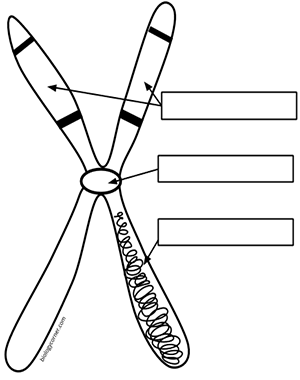
The chromosome theory of inheritance, also known as the chromosomal theory of inheritance, is a fundamental concept in genetics that explains how genetic information is passed from one generation to the next.
The fundamental tenants of the theory state that chromosomes carry genes that are passed from parents to offspring. Chromosomes undergo segregation and independent assortment during meiosis. These processes contribute to genetic diversity by shuffling the genes found on the chromosomes.
This simple worksheet shows a diagram of a chromosome and where it is located in the nucleus of the cell. Students use a word bank to label the chromatid, centromere, chromosomes, cell membrane, DNA, and nucleus. For fun, I also have a plush chromosome and several magnetic chromosomes to illustrate homologous pairs.
If you are looking for activities on creating karyotypes, try this cut-and-paste chromosome study or analyze a karyotype showing chromosome disorders. I also have a Google slides version of karyotyping where students drag chromosomes to their pairs and arrange them in order.
The Structure of the Chromosome
- DNA: Chromosomes are primarily made up of DNA (deoxyribonucleic acid), which contains the genetic information necessary for the development, functioning, and reproduction of living organisms. DNA is organized into units called genes, which carry the instructions for specific traits.
- Chromatin: When a cell is not dividing, the DNA in the chromosome exists in a less condensed form called chromatin. Chromatin consists of DNA wrapped around proteins called histones. The chromatin structure allows for the regulation of gene expression and facilitates DNA replication and repair.
- Sister chromatids: During the cell division process known as mitosis or meiosis, chromosomes condense further to form visible structures. Each chromosome consists of two identical sister chromatids, which are joined together at a region called the centromere. Sister chromatids contain identical copies of the chromosome’s DNA and are produced during DNA replication.
- Centromere: The centromere is a specialized region of the chromosome where the two sister chromatids are held together. It plays a crucial role in ensuring that each daughter cell receives the correct number of chromosomes during cell division.
This worksheet was created for introductory biology for students to practice labeling the parts of a chromosome.
Grade Level: 6-12
Time Required: 5 minutes

